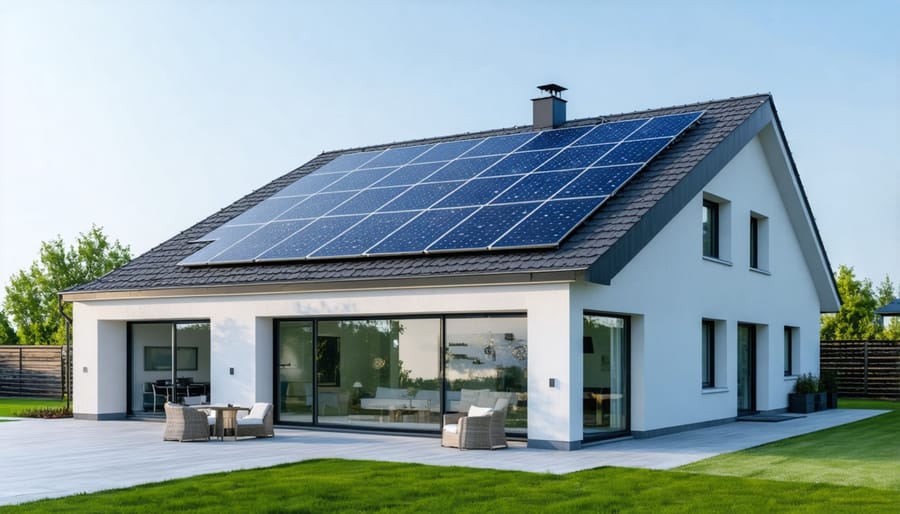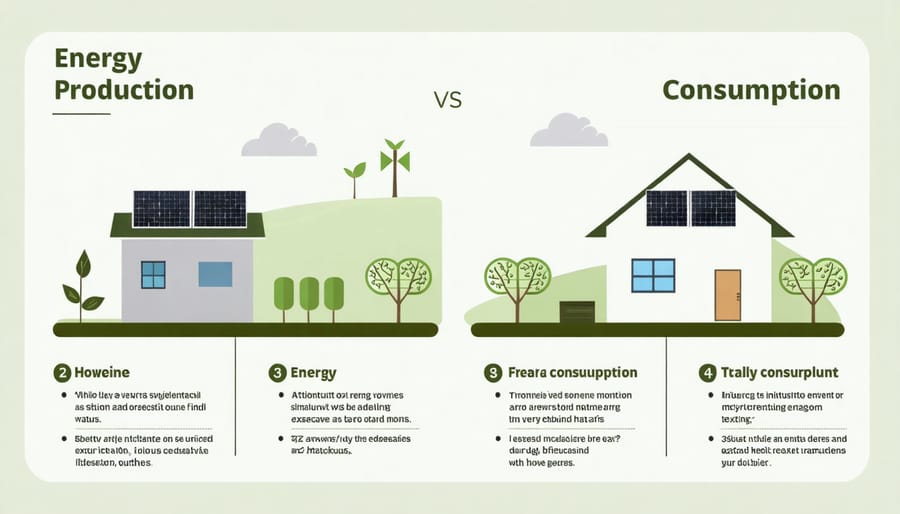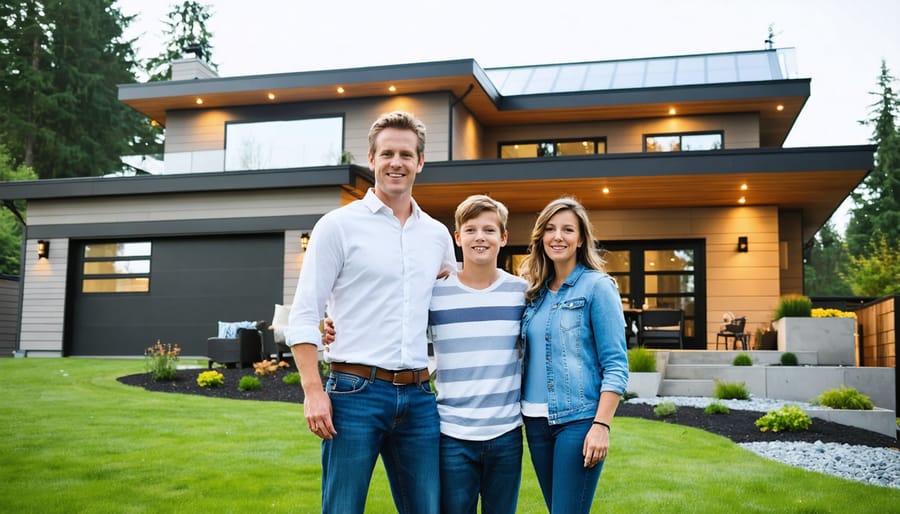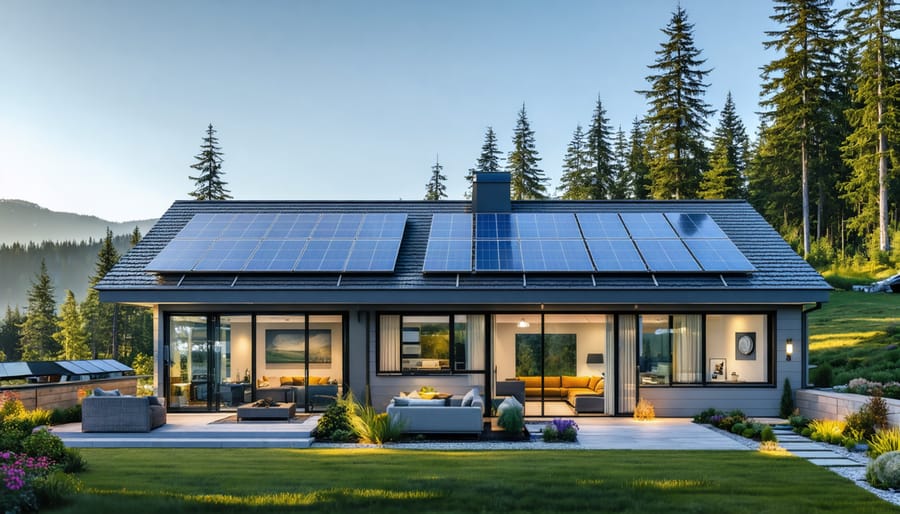Imagine living in a home that generates all the energy it needs, produces zero carbon emissions, and saves you thousands in utility bills each year. Zero energy houses – also known as net-zero homes – represent the future of sustainable living, combining cutting-edge solar technology with innovative design principles to achieve complete energy independence.
Here in British Columbia, where clean energy initiatives are rapidly expanding, zero energy homes are becoming increasingly achievable and affordable. These remarkable dwellings utilize a combination of solar panels, superior insulation, energy-efficient appliances, and smart home technology to produce as much energy as they consume over the course of a year.
The benefits extend far beyond environmental impact. Homeowners enjoy consistent indoor temperatures, improved air quality, and significant long-term cost savings. With government incentives and falling renewable energy prices, the initial investment in a zero energy home typically pays for itself within 7-10 years while providing decades of sustainable, independent living.
Whether you’re planning to build new or retrofit an existing home, achieving zero energy status is a practical goal that aligns with both personal comfort and environmental responsibility. Let’s explore how you can join the growing community of British Columbians embracing this revolutionary approach to home ownership.

What Makes a House Truly Zero Energy?
Energy Production vs. Consumption
In a zero energy home, the key is striking a perfect balance between energy production and consumption. Solar panels typically generate more electricity during summer months and peak daylight hours, while consumption patterns vary throughout the day and seasons. A well-designed system accounts for these fluctuations by producing excess energy during optimal conditions to offset periods of higher usage or lower production.
For the average BC home using 10,000 kWh annually, a properly sized solar array of 8-10 kW can achieve net-zero status. This system generates surplus power during sunny days, feeding it back into the grid through BC Hydro’s net metering program. During evenings or cloudy days, the home draws power from the grid, effectively using it as a battery.
The secret to maintaining zero energy status lies in smart consumption habits. Energy-efficient appliances, LED lighting, and proper insulation significantly reduce daily usage. Modern smart home systems can even automate energy use, running high-consumption appliances during peak solar production hours. By carefully monitoring both production and usage through home energy management systems, homeowners can optimize their consumption patterns to match their solar generation capacity.
Essential Design Elements
A zero energy house relies on several key design elements working together seamlessly. The building envelope serves as the foundation, featuring superior insulation in walls, floors, and roofs, typically achieving R-values above 40. Triple-pane windows with low-e coatings and insulated frames prevent heat loss while maximizing natural light.
Proper orientation is crucial, with the building’s longest axis running east-west to maximize southern exposure for passive solar gain. Large south-facing windows capture winter sun, while strategic overhangs provide summer shade. Thermal mass materials like concrete floors or stone walls store heat energy, releasing it slowly to maintain steady indoor temperatures.
An airtight construction with mechanical ventilation and heat recovery ensures optimal air quality while minimizing energy loss. Smart home automation systems monitor and control energy usage, adjusting heating, cooling, and lighting based on occupancy and time of day.
The integration of renewable energy systems, primarily rooftop solar panels, completes the zero energy equation. These systems are sized to match the home’s reduced energy needs, making net-zero status achievable in British Columbia’s climate.
Planning Your Zero Energy Home’s Solar System
Calculating Your Energy Needs
To achieve a true zero-energy home, the first step is calculating your household’s energy requirements accurately. Start by gathering your utility bills from the past 12 months to determine your annual energy consumption in kilowatt-hours (kWh). In British Columbia, the average household uses approximately 10,000 kWh per year, but your actual usage may vary significantly.
Create a detailed energy audit by listing all major appliances and their usage patterns. Consider seasonal variations – BC winters typically require more heating energy, while summer months might see increased cooling needs. Don’t forget to account for future changes, such as electric vehicle charging or home additions.
Once you understand your consumption, you can determine the solar capacity needed. Your daily solar panel production will vary based on your location, roof orientation, and local weather patterns. In BC, most residential systems require between 20-30 panels to achieve net-zero energy status.
Use our online calculator tool to input your specific details and receive a customized estimate. Remember to factor in energy efficiency improvements that could reduce your overall needs – sometimes, simple upgrades like LED lighting or improved insulation can significantly decrease the solar capacity required for your zero-energy goals.
Consider working with a local energy advisor who can provide a professional assessment and help you make informed decisions about your system size and configuration.

Solar Panel Placement and Optimization
In British Columbia’s diverse climate, strategic solar panel placement is crucial for achieving maximum energy production. The optimal solar panel orientation typically involves a south-facing installation at a 30-35 degree angle, though this may vary depending on your specific location within BC.
Local homeowners should consider several key factors when planning their solar installation. First, assess your roof’s structural integrity and ensure it can support the additional weight. Next, evaluate potential shading from nearby trees, buildings, or other obstacles that might affect panel performance throughout the year.
BC’s seasonal variations require special consideration. While summer months offer abundant sunlight, winter brings shorter days and more cloud cover. To compensate, many homeowners opt for slightly steeper panel angles (around 40 degrees) to maximize winter sun exposure and help snow slide off naturally.
Modern solar tracking systems can increase efficiency by up to 25% by following the sun’s path throughout the day. However, these systems require additional maintenance and may not be cost-effective for all installations. For most BC homes, fixed panels with proper positioning provide the best balance of performance and reliability.
Regular maintenance is essential for optimal performance. Schedule bi-annual cleaning to remove debris and check for damage, particularly after severe weather events. This simple routine can help ensure your panels continue operating at peak efficiency year-round.
Energy Storage Solutions
For a truly zero-energy home, effective home energy storage solutions are essential to maintain power during non-generating hours and cloudy days. In British Columbia, where seasonal variations significantly affect solar production, a well-planned storage system becomes even more crucial.
Most BC homeowners opt for lithium-ion battery systems, which offer excellent performance and longevity. These systems typically store between 10-15 kWh of energy, enough to power an average home through the evening and overnight hours. Popular options like the Tesla Powerwall and LG RESU have proven particularly effective in our climate.
While maintaining a grid connection provides a reliable backup, some remote properties in BC choose to go completely off-grid. This requires a larger battery bank and possibly a backup generator for extended periods of low solar production during winter months.
Smart energy management systems help maximize storage efficiency by automatically directing excess power to batteries during peak production and drawing from them during high-demand periods. Many BC homeowners find that combining battery storage with time-of-use optimization helps them achieve true zero-energy status while maintaining grid connection for additional security.
For those just starting their zero-energy journey, we recommend consulting with local installers who understand BC’s unique climate challenges and can recommend appropriately sized storage solutions.
BC Success Story: The Matthews Family Zero Energy Home
The Matthews family of Victoria, BC, achieved their dream of living in a zero energy home in 2021, demonstrating that net-zero living is both achievable and practical in British Columbia’s climate. John and Sarah Matthews, along with their two children, transformed their 1980s bungalow into a modern zero energy marvel through careful planning and strategic upgrades.
The family’s journey began with a comprehensive home energy audit, which identified key areas for improvement. They started by upgrading their insulation to R-60 in the attic and R-40 in the walls, and installing triple-pane windows throughout the house. The Matthews also replaced their aging gas furnace with an energy-efficient heat pump system, which handles both heating and cooling needs.
The cornerstone of their zero energy achievement was the installation of a 9.8 kW solar panel system on their south-facing roof. The system generates approximately 10,500 kWh annually, matching their household’s total energy consumption after their efficiency upgrades. During summer months, they feed excess power back into the grid, while drawing from it during darker winter days.
The project cost $65,000 in total, but the family received $12,000 in provincial and federal rebates. They estimate their annual energy savings at $2,800, putting them on track for a complete return on investment within 19 years. More importantly, their home now produces zero net carbon emissions and serves as a comfortable, modern living space.
“The most surprising thing,” says Sarah Matthews, “is how normal everything feels. We don’t sacrifice any comforts – we just get them more efficiently.” The family regularly hosts open houses for interested neighbors and has inspired five other households in their community to begin their own zero energy journeys.
The Matthews’ success story proves that achieving zero energy status is within reach for BC homeowners, combining smart technology choices with available incentives and a commitment to sustainable living.

Financial Planning and Incentives
Initial Investment Breakdown
Creating a zero-energy home in British Columbia requires careful planning and strategic investment in various components. While the initial costs may seem substantial, they typically lead to significant long-term savings. Based on current market rates in BC, here’s a breakdown of typical investments required:
Building envelope improvements, including superior insulation and high-performance windows, usually account for $30,000 to $45,000 of the total investment. These fundamental elements ensure minimal heat loss and optimal energy efficiency year-round.
The solar PV system, sized for an average BC home (typically 7-10 kW), ranges from $20,000 to $30,000 after rebates and incentives. This includes panels, inverters, and professional installation.
High-efficiency heating and cooling systems, such as air-source heat pumps, generally cost between $8,000 and $12,000. Energy-efficient appliances and LED lighting add approximately $5,000 to $8,000 to the total.
Smart home technology and energy monitoring systems, essential for optimizing energy usage, typically require an investment of $2,000 to $4,000.
While the total investment often ranges from $65,000 to $100,000, BC homeowners can access various rebates and tax incentives that can reduce these costs by 20-30%. Most homeowners report complete energy cost recovery within 10-15 years, making it a sound long-term investment.
Available Rebates and Programs
Building a zero-energy home in British Columbia has never been more attainable, thanks to numerous government incentives and support programs. The CleanBC Better Homes Program offers substantial rebates for energy-efficient upgrades, including up to $6,000 for heat pump installations and up to $2,000 for high-performance windows and doors. Homeowners can access comprehensive BC solar rebates that cover up to 50% of installation costs for solar PV systems.
The Canada Greener Homes Grant provides additional federal support of up to $5,000 for energy-efficient renovations and an extra $40,000 in interest-free loans. To qualify, homeowners must complete an EnerGuide home evaluation before and after improvements. This evaluation helps identify the most effective upgrades for your specific situation.
Local municipalities often offer supplementary incentives. For example, Vancouver residents can access additional rebates through the Home Energy Retrofit Program, while Victoria provides property tax exemptions for qualifying zero-energy homes.
BC Hydro’s Net Metering Program allows homeowners to connect their solar systems to the grid, earning credits for excess energy production. This program is essential for achieving true zero-energy status, as it enables energy banking during high-production summer months for use during darker winter periods.
Remember to work with certified contractors who understand local building codes and can help maximize available incentives. Many programs require pre-approval, so plan ahead and consult with experts early in your project.
Creating a zero-energy home in British Columbia is an achievable goal that combines smart design, efficient technologies, and renewable energy systems. By implementing the strategies discussed throughout this guide, homeowners can significantly reduce their environmental impact while enjoying long-term energy savings and increased property value.
The path to a zero-energy home starts with proper planning and assessment of your property’s potential. Begin by conducting a home energy audit and implementing basic efficiency measures like improved insulation and air sealing. From there, consider upgrading to high-efficiency appliances and installing a solar PV system sized to meet your annual energy needs.
Remember that local incentives and rebates can substantially reduce your initial investment. Connect with BC’s network of certified contractors and energy advisors who can help guide you through the process. Many communities also have support groups and resources for homeowners pursuing zero-energy goals.
For those ready to take the next step, we recommend:
– Scheduling a professional energy assessment
– Researching available rebates and financing options
– Consulting with local solar installers
– Connecting with zero-energy homeowners in your community
– Creating a phased implementation plan that fits your budget
With careful planning and the right support, your zero-energy home journey can begin today, contributing to a more sustainable future for British Columbia while providing you with energy independence and financial benefits for years to come.

